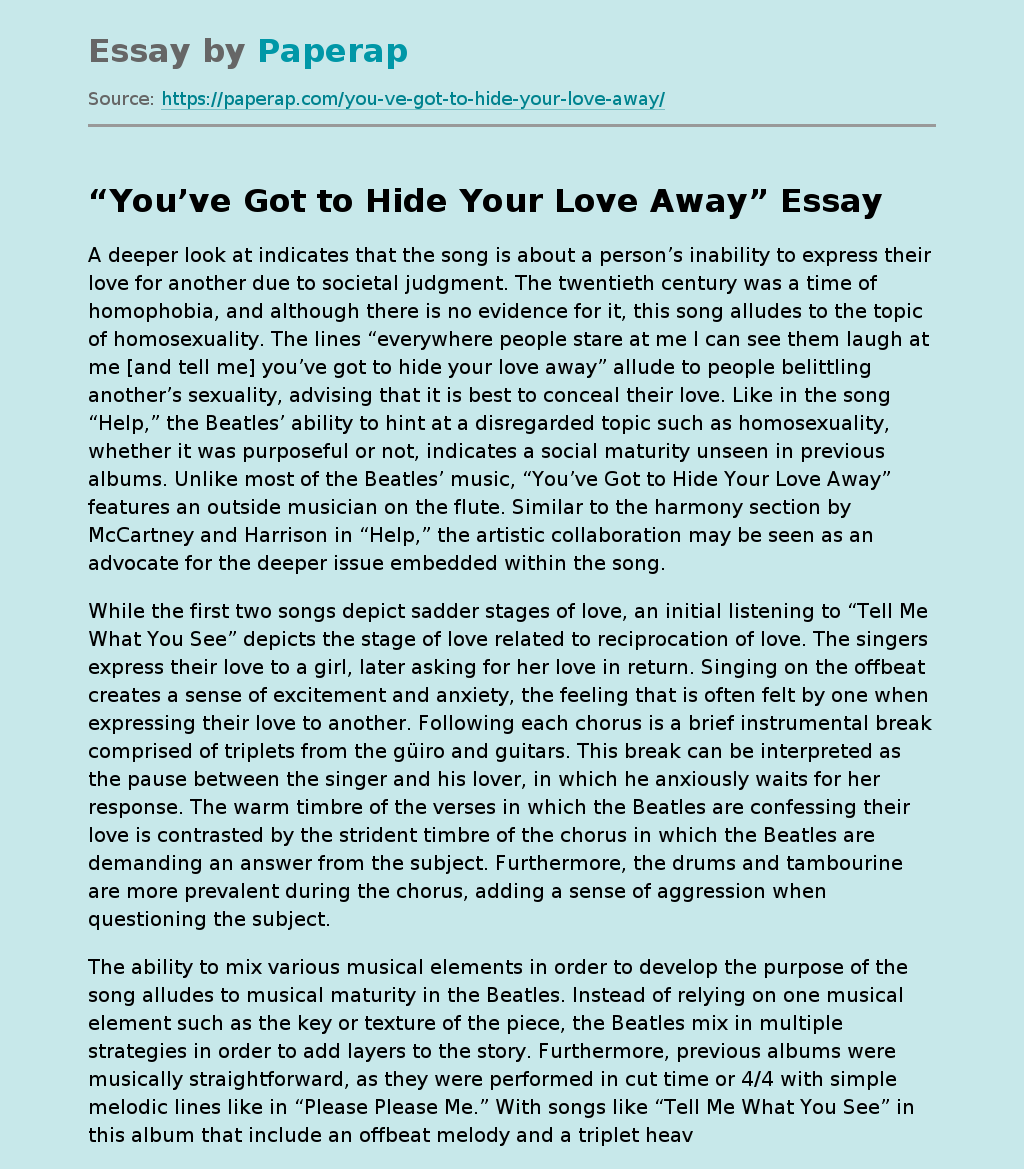“You’ve Got to Hide Your Love Away”
A deeper look at indicates that the song is about a person’s inability to express their love for another due to societal judgment. The twentieth century was a time of homophobia, and although there is no evidence for it, this song alludes to the topic of homosexuality. The lines “everywhere people stare at me I can see them laugh at me [and tell me] you’ve got to hide your love away” allude to people belittling another’s sexuality, advising that it is best to conceal their love.
Like in the song “Help,” the Beatles’ ability to hint at a disregarded topic such as homosexuality, whether it was purposeful or not, indicates a social maturity unseen in previous albums. Unlike most of the Beatles’ music, “You’ve Got to Hide Your Love Away” features an outside musician on the flute. Similar to the harmony section by McCartney and Harrison in “Help,” the artistic collaboration may be seen as an advocate for the deeper issue embedded within the song.
While the first two songs depict sadder stages of love, an initial listening to “Tell Me What You See” depicts the stage of love related to reciprocation of love. The singers express their love to a girl, later asking for her love in return. Singing on the offbeat creates a sense of excitement and anxiety, the feeling that is often felt by one when expressing their love to another. Following each chorus is a brief instrumental break comprised of triplets from the güiro and guitars.
This break can be interpreted as the pause between the singer and his lover, in which he anxiously waits for her response. The warm timbre of the verses in which the Beatles are confessing their love is contrasted by the strident timbre of the chorus in which the Beatles are demanding an answer from the subject. Furthermore, the drums and tambourine are more prevalent during the chorus, adding a sense of aggression when questioning the subject.
The ability to mix various musical elements in order to develop the purpose of the song alludes to musical maturity in the Beatles. Instead of relying on one musical element such as the key or texture of the piece, the Beatles mix in multiple strategies in order to add layers to the story. Furthermore, previous albums were musically straightforward, as they were performed in cut time or 4/4 with simple melodic lines like in “Please Please Me.” With songs like “Tell Me What You See” in this album that include an offbeat melody and a triplet heavy instrument solo, a new level of musical maturity is reached as these skills are hard to master.
“Tell Me What You See” similarly pulls on deeper topics; however, while the others covered heavy-hearted topics, this song draws upon religion. With knowledge of Lennon’s background, we find that the second phrase is reminiscent of a religious quote prevalent in Lennon’s childhood: “However black the clouds may be/In time they’ll pass away/Have faith and trust and you will see/God’s light make bright your day.”² The titular phrase could in fact ask the listener or subject to tell the singer what they see on a spiritual level. Although the verse is a paraphrase of a well-known quote, it is not evident that the song is religious. The song, in fact, could be a man’s desire for another. The ability, however, for the Beatles’ to sing lines similar to a religious quote during the religious crisis of the 1960s, when a change in religion was coupled with social and cultural reform, indicates the Beatles’ willingness to discuss a sensitive topic³.
The 1960s marked a period when the Beatles conflicted with the faith of Christianity; hinting at religion was a courageous move on their end, considering numerous fans were religious. Hinting at a sensitive topic indicates the Beatles’ social awareness, like that seen in the rest of the album. It is without a doubt that the Beatles’ have displayed their new maturity in the featured fourteen songs of the album. By pulling song lyrics from personal and societal experiences, it is clear that this album means more to the Beatles than just another production: it is a compilation of emotional love stories and personal development. The first song “Help” reminds fans of older rock and roll classics of the Beatles while suggesting at a cry for help from depression.
As we continue through the album, diversity is seen as a result of Bob Dylan’s effect on the music group. Their folksy musicality and meaningful lyrical choice in the next thirteen songs work hand in hand to create pieces that are complete in carrying a message to their audience, whether it be about a stage of love or an issue affecting society. The album finishes off with two classics, “Yesterday” and “Dizzy Miss Lizzy;” the former, a heart-wrenching piece about break up is followed by a light song throwing it back to their rock and roll period, thereby encompassing their new characteristic with their old, almost as if to proclaim, “we are still the Beatles.”
“You’ve Got to Hide Your Love Away”. (2021, Dec 13). Retrieved from https://paperap.com/you-ve-got-to-hide-your-love-away/

